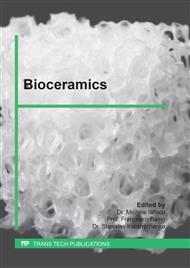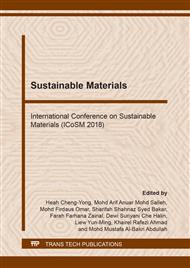p.83
p.90
p.96
p.102
p.109
p.115
p.121
p.127
p.134
TiC-Coated Carbon Black Particles as a Bioactive Ceramic Compound for Application of Bone Tissue Engineering
Abstract:
Titanium carbide-coated carbon black particles (TCBs) were synthesized via reaction of metallic titanium powder with carbon black powder in a molten potassium chloride at 900°C for 4 hours in argon atmosphere to study their biological properties to be used as a bioactive ceramic compound for bone formation. Phase compositions and morphologies were characterized by electron diffraction spectroscopy (EDS) and scanning electron microscope (SEM). Core-shell structure was examined by transmission electron microscope (TEM). Biofunctionalities were considered by cell proliferation and protein synthesis. titanium and carbon peak were found, on an EDS curve of the as-synthesized powder, indicating the complete reaction. The shape and size of as-synthesized powder and as-received carbon black powder are similar, as it is noticed the template growth mechanism of the reaction. However, the surface morphology of as-synthesized powder is different because of its rough surface. Core-shell structure of the as-synthesized powder was revealed by TEM that an ultra-thin layer of titanium carbide was successfully coated on a carbon black particle. Biological testing showed, as compared to a control, a significant enhancement in cell proliferation and protein synthesis of the as-synthesized TCBs suggesting a good candidate as a bioactive compound for biomedical applications.
Info:
Periodical:
Pages:
109-114
Citation:
Online since:
August 2018
Price:
Сopyright:
© 2018 Trans Tech Publications Ltd. All Rights Reserved
Share:
Citation:



